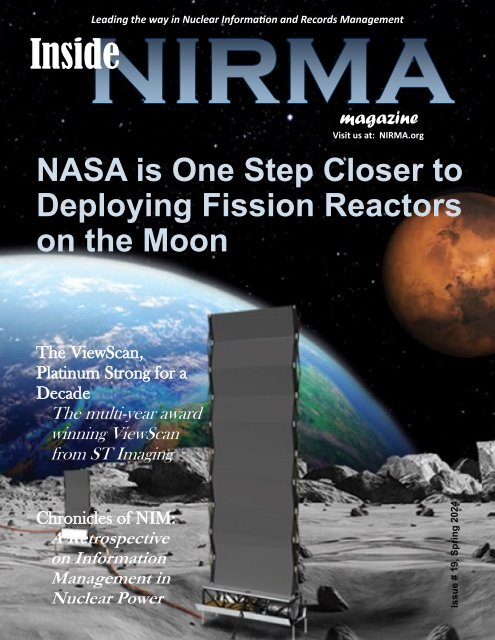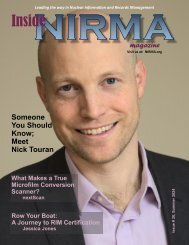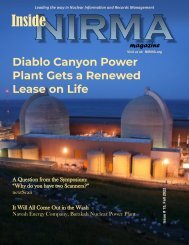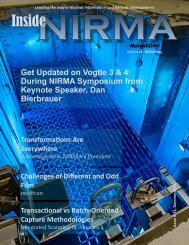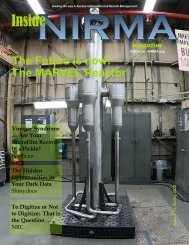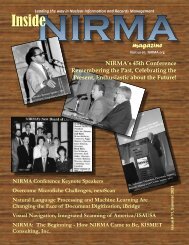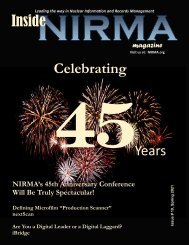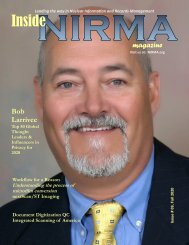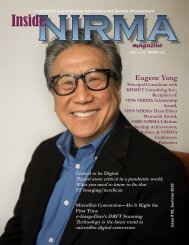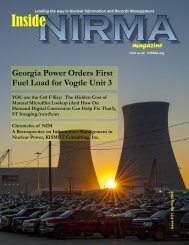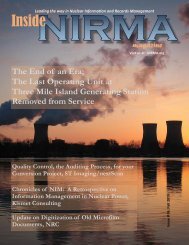Spring 2024 Inside NIRMA Magazine
Create successful ePaper yourself
Turn your PDF publications into a flip-book with our unique Google optimized e-Paper software.
Issue # 19, <strong>Spring</strong> <strong>2024</strong><br />
<strong>Inside</strong><br />
Leading the way in Nuclear Information and Records Management<br />
magazine<br />
Visit us at: <strong>NIRMA</strong>.org<br />
NASA is One Step Closer to<br />
Deploying Fission Reactors<br />
on the Moon<br />
The ViewScan,<br />
Platinum Strong for a<br />
Decade<br />
The multi-year award<br />
winning ViewScan<br />
from ST Imaging<br />
Chronicles of NIM:<br />
A Retrospective<br />
on Information<br />
Management in<br />
Nuclear Power
CONTENT<br />
The ViewScan, Platinum Strong for a Decade<br />
The multi-year award winning ViewScan from ST Imaging<br />
By Matt Anderson, nextScan/ST Imaging<br />
NASA is One Step Closer to Deploying Fission Reactors on the Moon<br />
By Carolyn Collins Peterson, Universe Today<br />
Chronicles of NIM: A Retrospective on Information Management in<br />
Nuclear Power<br />
By Ellen Ryan, Docuvela<br />
<strong>NIRMA</strong>’s Power of Giving;<br />
Sharing the Good News<br />
On the Cover: An artist's concept of possible nuclear<br />
fission reactors on the Moon. Credit: NASA<br />
2 <strong>Spring</strong> <strong>2024</strong> <strong>NIRMA</strong>.org <strong>Inside</strong> <strong>NIRMA</strong>
in every issue<br />
MESSAGE FROM THE BOARD—4<br />
SYMPOSIUM CORNER—10<br />
TREASURER REPORT—13<br />
PDBU NEWS—14<br />
M&MBU NEWS—15<br />
RIMBU NEWS—16<br />
INDUSTRY NEWS—17<br />
Letter from the Editors<br />
We at <strong>Inside</strong> <strong>NIRMA</strong>, value your opinion and are<br />
always looking to improve our magazine. Let us<br />
know what you like and dislike and what you’d<br />
like to see more of. Share your thoughts with our<br />
Communication Team at<br />
DevereauxInc@outlook.com.<br />
If you haven’t already done so, please take a<br />
moment to follow <strong>NIRMA</strong> on X<br />
(formerly Twitter) and Instagram,<br />
like <strong>NIRMA</strong> on Facebook, and<br />
connect with <strong>NIRMA</strong> on<br />
LinkedIn.<br />
Thanks for reading. Please keep in<br />
touch!<br />
Neal and Sandra Miller<br />
Editors<br />
Editors<br />
Neal and Sandra Miller<br />
DevereauxInc@outlook.com<br />
Advertising<br />
Neal.F.Miller@gmail.com<br />
<strong>NIRMA</strong> Headquarters<br />
Sarah Perkins<br />
<strong>NIRMA</strong> Administrator<br />
nirma@nirma.org<br />
In addition to our own<br />
articles, <strong>Inside</strong> <strong>NIRMA</strong><br />
publishes guest articles from<br />
agencies and vendors. Please<br />
be advised that the views and<br />
opinions expressed in these<br />
articles are those of the<br />
authors and do not<br />
necessarily reflect the<br />
opinions of <strong>NIRMA</strong> or its<br />
Board of Directors.<br />
Back to Content | <strong>Inside</strong> <strong>NIRMA</strong> <strong>NIRMA</strong>.org <strong>Spring</strong> <strong>2024</strong> 3
MESSAGE FROM THE BOARD<br />
Y<br />
our newly formed Board of Directors met in<br />
January for the annual Winter Board meetings.<br />
Through sharing and discussion, we learned<br />
there is a lot going on in <strong>NIRMA</strong> and the outlook is<br />
very bright for our organization.<br />
We are a young Board, but one with great<br />
aspirations for <strong>NIRMA</strong>. Our senior member is in her<br />
sixth year on the Board, with one member in her<br />
second year and two brand new members. While<br />
individuals with historical knowledge have finished<br />
their terms of service, we know how to reach out to<br />
them for advice. We are going to be respectful of the<br />
traditions of <strong>NIRMA</strong> and at the same time, asking if<br />
new perspectives are possible. Why must we do ABC<br />
and why can’t we do XYZ? We have no plans to<br />
change things just to change them; there will need to<br />
be a purpose. We have had high energy over the past<br />
few years with new ideas and we plan to continue<br />
down that line of thinking. Fresh thoughts are<br />
refreshing.<br />
<strong>2024</strong> <strong>NIRMA</strong> Board of Directors<br />
(L-R) Lou Rofrano (Director of Technical Programs),<br />
Sheila Pearcy, CRA (Director of Infrastructure),<br />
Bruce Walters, CRM/NS (President), Stephanie<br />
Price (Secretary), Kathi Cole, CRM (Vice President).<br />
Inset: Tammy Cutts (Treasurer).<br />
We have many things on our plate. What is next for<br />
SIGET? What tool can we adopt for a membership<br />
Q&A resource? Can we affordably host a Symposium<br />
in the eastern USA? What TGs need Board approval<br />
for their reaffirmation? How can we support the<br />
Business Units who are the lifeblood of <strong>NIRMA</strong>?<br />
2023 Was another great year for <strong>NIRMA</strong> and the<br />
Board is pleased to share the following<br />
accomplishments with our membership:<br />
• Approval of Dan Cassity as the new Technical<br />
Specialist to the Board.<br />
• Approval and roll out of the new <strong>NIRMA</strong> logo.<br />
• Creation of a “terms of use” for the <strong>NIRMA</strong><br />
Technical Guidelines (TGs).<br />
• Approval to change symposium refund policy<br />
verbiage - All money paid will be returned;<br />
however, <strong>NIRMA</strong> will retain $400.00 ($325 for<br />
the membership fee; $75.00 for administrative<br />
fees).<br />
• Approval to assess Board of Director<br />
nominations based on a personal commitment<br />
letter.<br />
• Updated AD03, Application and use of the<br />
<strong>NIRMA</strong> Logo to add the new <strong>NIRMA</strong> logo and<br />
remove addresses where necessary.<br />
• Updated AP02, Annual Election and Board of<br />
Directors Reorganization Process to include new<br />
requirement for a personal commitment letter<br />
from board nominees and a sample letter. Added<br />
wording regarding board candidates’ attendance<br />
at the board meeting following the Annual<br />
Business meeting.<br />
We have new leadership in each of the Business<br />
Units and we can tell that progress is being made in<br />
each one. Lots of great ideas coming from them. And<br />
our ANSI Standard on Configuration Management has<br />
completed its last audit hurdle and is officially, finally,<br />
final.<br />
Personal growth comes from stepping outside of our<br />
comfort zone and reaching a little bit higher. Each of<br />
4 <strong>Spring</strong> <strong>2024</strong> <strong>NIRMA</strong>.org <strong>Inside</strong> <strong>NIRMA</strong>
us should be considering that since this is a very<br />
successful volunteer organization, because of the<br />
activity of our members, and we want to grow in<br />
knowledge and abilities, what first or next step can we<br />
take to learn more, to help more, to grow more? Each<br />
current Board member has spent time in the Business<br />
Units, learning and growing. You might be good at<br />
writing … or want to learn to be a better writer. You<br />
might have a marketing degree or want to learn about<br />
the process. You might love to help educate others or<br />
want to be educated. There’s a place for each of us,<br />
from brand new to the field (needing education) to<br />
being around the block a few times (need to share with<br />
or mentor others). <strong>NIRMA</strong> is our organization … your<br />
organization. Get active. Get involved. Ask questions.<br />
Grow. Teach. Become a better you! Even the savvy<br />
old members still learn things … and can learn from the<br />
newbies. You need coaching, we have many coaches.<br />
You like to coach, we always need more coaches.<br />
Everyone knows something, but no one knows<br />
everything.<br />
We hope you take your opportunity as a <strong>NIRMA</strong><br />
member (or your desire to be <strong>NIRMA</strong> member) as an<br />
opportunity to grow in our wonderful and necessary<br />
profession. Many of us are here to help you in your<br />
process. You just have to hit the Activate button.<br />
is our organization …<br />
your organization. Get<br />
active. Get involved.<br />
Ask questions.<br />
Grow. Teach.<br />
Become a better you!<br />
Back to Content | <strong>Inside</strong> <strong>NIRMA</strong> <strong>NIRMA</strong>.org <strong>Spring</strong> <strong>2024</strong> 5
THEBESTJUSTGOTBETTER<br />
Introducingthenextgenerationofmulti-formatconversionscanning,<br />
theFlexScan+from nextScan.<br />
Microfilm Microfiche ApertureCards<br />
Theonlytruemulti-formatconversionpackagethatdelivershigh-speedprecision<br />
scanningwithuniquecustom softwareapplicationsthatenableenhancedand<br />
powerfulscanningcapabilities.<br />
4x<br />
EFFICIENCY<br />
SimultaneousScan,<br />
Audit,Index,andOutput<br />
forincreasedefficiency.<br />
5x<br />
PRODUCTIVITY<br />
Enablemaximum<br />
workowwith5standard<br />
workstations.Optional<br />
remotecapabilities.<br />
2x<br />
NATIVEIMAGE<br />
RESOLUTION<br />
Highprecisionoptics<br />
combinedwith<br />
proprietarylighting<br />
technologynearlydouble<br />
nativeimageresolution<br />
deliveringunmatched<br />
imagequality.<br />
Auto-Focus ReliableImageCapture High-ResolutionImages<br />
Streamlineworkflowwith<br />
ahands-offapproachwith<br />
auto-focustechnology.No<br />
needforadjustments,the<br />
FlexScan+captureseach<br />
imageclearandlegible.<br />
Linescanningtechnology<br />
from nextScanensures<br />
mediaisscanned<br />
top-to-botom,and<br />
end-to-end,capturing<br />
everypieceofinformation<br />
onthefilm.<br />
Proprietarylightingcombined<br />
withLUMINTEC®technology<br />
andhigh-precisionoptics<br />
capturerawdetailedimages,<br />
expandingtheabilitytosee<br />
finedetailswithintheoriginal<br />
record.<br />
208.514.4000 | sales@nextscan.com | www.nextscan.com | FolowUs:
The ViewScan,<br />
Platinum Strong for a Decade<br />
The multi-year award<br />
winning ViewScan from<br />
ST Imaging<br />
T<br />
his past January, ST<br />
Imaging’s line of ViewScan<br />
microfilm scanners received<br />
its 10 th consecutive Modern Library<br />
Award (MLA). While the library and<br />
nuclear industry are vastly different,<br />
they share many things in common.<br />
Librarians and Record Managers<br />
both know where information is<br />
located, how to access it, and what<br />
to do with it once found.<br />
Over the past ten years, librarians<br />
from all over the country have<br />
evaluated different equipment they<br />
use daily. Time after time, they<br />
ranked the ViewScan microfilm<br />
scanner with the highest remarks,<br />
top of the class, the Platinum award.<br />
No other microfilm scanner has<br />
been awarded the Platinum<br />
distinction for ten consecutive years.<br />
“We went from the<br />
"stone age" to<br />
[ViewScan]<br />
scanners and never<br />
looked back!”<br />
Each librarian is invited to<br />
provide additional feedback. One<br />
such comment this past year was,<br />
“The ST-ViewScan scanner is very<br />
simple to use and has great quality,<br />
plus the Service is excellent on<br />
them.” Another librarian remarked,<br />
“We went from the "stone age" to<br />
these scanners and never looked<br />
back!”<br />
By replacing old and outdated<br />
microfilm equipment, even firstgeneration<br />
digital microfilm<br />
scanners, an organization will be able<br />
to work at a quicker pace and on a<br />
more secure setting. The modern<br />
ViewScan 4 microfilm scanner offers<br />
features such as auto-focus<br />
technology, the ability to combine<br />
scans into one image, OCR, and<br />
more to streamline the microfilm<br />
data retrieval process.<br />
Modern equipment is essential in<br />
today’s computer-based world.<br />
Security threats are a constant focus<br />
of almost every organization. Old<br />
micrographic scanners are not<br />
designed for modern Windows 11<br />
Operating Systems. Replacing old<br />
equipment with current models is<br />
important for a secure working<br />
By Matt Anderson<br />
environment.<br />
Today, ST Imaging is producing<br />
the ViewScan 4 microfilm scanner.<br />
Over the last 20 years, through the<br />
advancement of technology, the<br />
ViewScan has continued its own<br />
development. Those years have seen<br />
the camera evolution from a 5-<br />
megapixel camera to a 14-megapixel<br />
camera to the 18-megapixel camera<br />
in use today.<br />
Additionally, the connection<br />
between not only the camera and<br />
scanner, but also the scanner and<br />
computer has changed. Early digital<br />
models utilized SCSI connectors.<br />
Next was the age of the FireWire.<br />
Then came the two waves of USB<br />
drives, 2.0 and 3.0 SuperSpeed. The<br />
current ViewScan offering will<br />
always be compatible with the latest<br />
operating systems and computers.<br />
ST Imaging strives to deliver the<br />
best-in-class equipment for those<br />
using microfilm and microfiche.<br />
Year after year, the judges have<br />
agreed that ViewScan is an award<br />
winner.<br />
Back to Content | <strong>Inside</strong> <strong>NIRMA</strong> <strong>NIRMA</strong>.org <strong>Spring</strong> <strong>2024</strong> 7
NASA is One Step Closer to<br />
Deploying Fission Reactors<br />
on the Moon<br />
By Carolyn Collins Peterson<br />
W<br />
hat’s the most important<br />
thing you need to live and<br />
work on the Moon? Power.<br />
For NASA’s upcoming<br />
Artemis program, getting power to<br />
lunar bases is a top priority. That’s<br />
why the agency created its Fission<br />
Surface Power Project. The idea is to<br />
develop concepts for a small nuclear<br />
fission reactor to generate electricity<br />
on the lunar surface.<br />
The project just finished its initial<br />
phase (which began in 2022), which<br />
consisted of three $5 million<br />
contracts to commercial partners to<br />
develop fission reactor designs.<br />
NASA selected Lockheed Martin in<br />
Bethesda, MD, Westinghouse of<br />
Cranberry, PA, and IX of Houston,<br />
TX each for a 12-month Phase 1<br />
award to further develop preliminary<br />
designs. Each partner was tasked to<br />
offer a design of the reactor and<br />
systems for power conversion, heat<br />
rejection, and power management<br />
and distribution. Of course, the<br />
partners needed to provide estimated<br />
costs for their systems and<br />
development plans. The ultimate<br />
goal was to create a system that<br />
could support lunar bases for a<br />
decade. The designs would also serve<br />
as pathways to plan and build similar<br />
systems on Mars.<br />
Power systems spell the difference<br />
between success and failure in any<br />
mission. For the Moon and Mars, it’s<br />
the difference between life and<br />
death. Nuclear power is the most<br />
likely route to service long-term<br />
power needs. “A demonstration of a<br />
nuclear power source on the Moon<br />
is required to show that it is a safe,<br />
clean, reliable option,” said Trudy<br />
Kortes, program director,<br />
Technology Demonstration Missions<br />
within NASA’s Space Technology<br />
Mission Directorate at NASA<br />
Headquarters in Washington. “The<br />
lunar night is challenging from a<br />
technical perspective, so having a<br />
source of power such as this nuclear<br />
reactor, which operates independent<br />
of the Sun, is an enabling option for<br />
long-term exploration and science<br />
efforts on the Moon.”<br />
Why Fission Reactors?<br />
Let’s face it—living and working<br />
on the Moon presents a lot of<br />
challenges. Safe, clean power helps<br />
overcome many of the dangers that<br />
lunar explorers will face. Solar power<br />
provides a dependable source of<br />
8 <strong>Spring</strong> <strong>2024</strong> <strong>NIRMA</strong>.org Back to Content | <strong>Inside</strong> <strong>NIRMA</strong>
Nuclear fission power plants like these could enable long-term<br />
exploration of the Moon for both humans and robotic probes.<br />
Credit: NASA<br />
requirements on purpose because<br />
we wanted them to think outside<br />
the box.”<br />
Now with feedback from the<br />
commercial partners, NASA<br />
begins working on a Phase 2<br />
solicitation for 2025. After that,<br />
the agency expects delivery of a<br />
system for use on the Moon in the<br />
early 2030s. In the distant future,<br />
after the systems have gone<br />
through their “baptism by fire” on<br />
the Moon, NASA will likely<br />
redesign a nuclear fission reactor<br />
specifically for use on Mars.<br />
power to keep things going. But, at<br />
least half of the time, solar power<br />
grids will be in darkness during the<br />
lunar night. That’s not to say solar<br />
power won’t be used. But, another<br />
power source is important to have.<br />
That’s where fission reactors come<br />
in handy.<br />
NASA and other agencies could<br />
put nuclear reactors in places that<br />
spend their time in partial or full<br />
shadow. In many cases, in<br />
situ reservoirs of ice exist in the<br />
same regions. The advantage of<br />
nuclear reactors is that they can<br />
operate full-time, regardless of<br />
whether there’s sunlight or not.<br />
That’s a big plus for power needs<br />
during the 14-night-long lunar<br />
night.<br />
Note that NASA isn’t saying that<br />
ONLY nuclear fission generators<br />
will be used on the Moon. A<br />
combination of solar and nuclear<br />
installations will likely supply the<br />
electricity needs of habitats and<br />
science labs.<br />
Reactor Specs for the<br />
Moon and Beyond<br />
In its solicitation for further work<br />
on the designs, NASA wanted to see<br />
plans for reactors that would last at<br />
least a decade without human<br />
intervention. This reduces any<br />
threats from accidental radiation<br />
exposure and allows lunar explorers<br />
to focus on their primary science and<br />
exploration tasks.<br />
The specs for the reactor design<br />
specify that it be under six metric<br />
tons and produce 40 kilowatts of<br />
power. That is enough to<br />
demonstrate the capability of the<br />
system and provide power for<br />
habitats, grids, and science<br />
experiments. If you put the same<br />
reactor on Earth in a typical<br />
neighborhood, it would be enough<br />
to power 33 homes.<br />
The agency designed the<br />
requirements to be open and flexible<br />
so that each company could feel free<br />
to explore new directions when it<br />
came to the designs they submitted.<br />
“There was a healthy variety of<br />
approaches; they were all very unique<br />
from each other,” said Lindsay<br />
Kaldon, Fission Surface Power<br />
project manager at NASA’s Glenn<br />
Research Center in Cleveland. “We<br />
didn’t give them a lot of<br />
For More Information, click on<br />
the links below:<br />
NASA’s Fission Surface Power<br />
Project Energizes Lunar<br />
Exploration<br />
NASA Fission Surface Power<br />
Project<br />
Not a <strong>NIRMA</strong><br />
Member?<br />
Click here<br />
and join<br />
TODAY!<br />
Back to Content | <strong>Inside</strong> <strong>NIRMA</strong> <strong>NIRMA</strong>.org <strong>Spring</strong> <strong>2024</strong> 9
g<br />
reetings everyone. In less than six months,<br />
we will be gathering again for the <strong>2024</strong><br />
Nuclear Information Management<br />
Symposium (August 5-7), now to be referred to as<br />
<strong>NIRMA</strong> 24 SYMPOSIUM, at the JW Marriott<br />
Resort and Spa in Las Vegas, Nevada.<br />
Symposium registration fees, which include the<br />
2025 membership fee, did not change from last<br />
year’s pricing.<br />
The Call for Papers has been published in a<br />
special edition of our monthly<br />
email in January and is also<br />
available on our <strong>NIRMA</strong><br />
website (click here). I<br />
encourage you to register as a<br />
Speaker for a discount, share<br />
your experiences, and educate<br />
the rest of us. As we witnessed<br />
in 2023, we have a lot of<br />
knowledgeable members in<br />
<strong>NIRMA</strong>, with some new folks<br />
coming from as far as Japan,<br />
Korea, and the United Arab<br />
Emirates. As a speaker, you<br />
will have an audience who will<br />
appreciate you taking that leap<br />
of faith. Give being a teacher<br />
and a learner a try this year. A<br />
list of possible topics is<br />
included on the Call for<br />
Papers. Case Studies are fantastic because they are<br />
actual experiences that colleagues are sharing,<br />
whether a project or process went quite well or<br />
horribly wrong. We can always learn from each of<br />
our successes and failures. Please share yours.<br />
We plan to continue offering a Fundamentals<br />
track for newbies, advanced tracks for the seasoned<br />
vets, and breaks for short networking opportunities,<br />
all in order to incorporate what you have come to<br />
expect educationally at the symposium.<br />
We have invited nearly two dozen of our exhibitor<br />
contacts to attend the Symposium and will have an<br />
Exhibitor Hall just as we have had in past years.<br />
Last year, you may recall, we had 13 exhibitors<br />
participate and with your input, we may have more<br />
this time. And as is routine, we will host a<br />
Networking Reception with them at the end of the<br />
day on Tuesday. If you are an exhibitor and want this<br />
opportunity, please contact Sarah at<br />
nirma@nirma.org to register.<br />
We continue to look for companies to sponsor<br />
events such as meals or after-hour receptions. Your<br />
company will be recognized on our website and at<br />
the symposium.<br />
For planning purposes,<br />
know that Business Unit<br />
meetings, including a SIGET<br />
working group, will be all day<br />
Thursday, August 9th. RIMBU<br />
may likely continue on Friday<br />
morning, August 10th. Please<br />
schedule your trip to Las Vegas<br />
to include an extra day (plus) to<br />
attend these important<br />
meetings.<br />
On the <strong>NIRMA</strong> website<br />
under the Annual Symposium<br />
tab are links to register for the<br />
Symposium, to Speak, to<br />
Sponsor, and to reserve your<br />
hotel room. The Marriott offers<br />
a limited number of rooms at<br />
the discounted Symposium rate,<br />
so you might want to reserve your room soon<br />
The Board is also working on a pre-Symposium<br />
Sunday Outing, so you may want to arrive in time to<br />
join in.<br />
Last year was a spirited event, as colleagues got to<br />
reconnect and learn, plus we had 37 first-timer<br />
attendees who jumped right into it. We are working<br />
to improve upon the experience and to offer more<br />
opportunities for our attendees, exhibitors, and<br />
sponsors for <strong>NIRMA</strong> 24 Symposium. You really will<br />
want to join us. The entire Board plans to be there in<br />
August and can’t wait to greet you in person.<br />
10 <strong>Spring</strong> <strong>2024</strong> <strong>NIRMA</strong>.org Back to Content | <strong>Inside</strong> <strong>NIRMA</strong>
It has come to our attention that <strong>NIRMA</strong> members<br />
not only excel in the records management, document<br />
control, information management arena, but also are<br />
generous with their time and give back to their<br />
communities in many ways. One of our new features<br />
for <strong>2024</strong> will recognize <strong>NIRMA</strong> members and their<br />
volunteer efforts.<br />
If you volunteer, we’d love to hear from you. Just<br />
send us a paragraph on what you are doing and why it is<br />
important to you, along with a photo and a description<br />
<strong>NIRMA</strong>’s<br />
Power of Giving<br />
and we will use your write up in a future edition of <strong>Inside</strong><br />
<strong>NIRMA</strong>.<br />
Special thanks to Eugene Yang for sharing this<br />
wonderful story of love, compassion and giving back<br />
and for helping us kick off this new feature.<br />
Neal and Sandy Miller<br />
<strong>Inside</strong> <strong>NIRMA</strong> Editors<br />
DevereauxInc@outlook.com<br />
Neal.F.Miller@gmail.com<br />
Sharing the Good News<br />
E<br />
ugene Yang, <strong>NIRMA</strong> Lifetime Member and<br />
Principal Consultant of KISMET Consulting,<br />
Inc., took the opportunity this past January to<br />
go on a mission trip to Ethiopia. He is passionate about<br />
meeting the physical needs of impoverished<br />
communities and relating the Good News of Jesus<br />
Christ. There, he helped to distribute shoes provided by<br />
his church, as well as participate in teaching math and<br />
English to children who live at the city dump. Eugene<br />
also attended a meeting with church leaders in a<br />
predominantly Muslim area of the country to encourage<br />
their work in spreading the gospel, as well as helping<br />
with math and english to children attending a Muslim<br />
school.<br />
Handing out a pair of shoes to an incredibly happy<br />
child.<br />
Listening to a child read John 3:16 in his native<br />
language (Amharic).<br />
Back to Content | <strong>Inside</strong> <strong>NIRMA</strong> <strong>NIRMA</strong>.org <strong>Spring</strong> <strong>2024</strong> 11
By Eugene Y. Yang,<br />
Principal Consultant<br />
KISMET Consulting, Inc.<br />
One of the best things in my career has been crossing paths with great people who have a<br />
passion for information management. In this issue, you folks are in for a treat, as I’ve<br />
invited Ellen Ryan, co-founder of Docuvela, to be my guest in this column. Ellen has<br />
consulted and implemented in the content services industry for over 25 years, having<br />
previously worked with Hyland, Alfresco, Technology Services Group, and Accenture.<br />
What’s Next for Content and Records<br />
Management?<br />
By Ellen Ryan<br />
C<br />
hanges in the technology we have used to<br />
manage content and records are more frequent<br />
than many of us might wish for. Image and<br />
Document Management, a term initially coined in the<br />
mid-1990s, became Enterprise Content Management<br />
(ECM) in the late 1990s, and eventually morphed into<br />
Content Services Platform (CSP) around 2017 when<br />
Gartner declared the “Death of ECM and Birth of<br />
Content Services.” For years, vendors and many end<br />
users wished to consolidate their content and records<br />
in one single repository. Despite this desire, the<br />
“enterprise-wide” consolidation failed to materialize<br />
(for many reasons), and Gartner’s post turned out to<br />
be very predictive of the industry demands we see<br />
today.<br />
Gartner defines Content Services as:<br />
“A set of services and microservices, embodied as an<br />
integrated product suite and applications that share common<br />
APIs and repositories. A CSP exploits diverse content<br />
types and serves multiple constituencies and numerous use<br />
cases across an organization.”<br />
The key phrase in the definition above is “sharing<br />
common APIs and repositories.” This means that<br />
records are easily accessible by your records<br />
management (RM) components and other services<br />
such as Asset Management Suites, manufacturing<br />
systems, and ERP Systems. Content and records<br />
management solutions are increasingly becoming<br />
“headless repositories” — with a focus on serving<br />
other applications rather than being the tool of choice<br />
for most users. As a result, what customers need from<br />
a content or records management system is pivoting.<br />
For a majority of implementations, the key<br />
components of any solution are very simple and<br />
include:<br />
• Governance - A secure repository that is<br />
searchable, controls revisions, manages retention,<br />
offers granular access permissions, and provides<br />
compliant auditability.<br />
• ROI - Most content and records management<br />
systems are expensive and complex to maintain.<br />
12 <strong>Spring</strong> <strong>2024</strong> <strong>NIRMA</strong>.org Back to Content | <strong>Inside</strong> <strong>NIRMA</strong>
Customers are looking for ways to simplify their IT<br />
stack, reduce costs, and limit their dependency on<br />
expensive vendors and consultants.<br />
• Integration - Any modern system needs to<br />
support ingestion from a variety of sources and<br />
allow easy, compliant access to multiple<br />
applications.<br />
Many vendors claim to provide “content services”<br />
in their ECM and RM offerings. However, the<br />
technology provided by these vendors has often not<br />
changed architecturally in the past twenty years. The<br />
content, records, and associated metadata continue to<br />
reside behind proprietary databases and locked-down<br />
API layers. What’s more, these legacy vendors are not<br />
motivated to innovate and provide open platforms —<br />
focusing rather on keeping their platforms sticky (aka<br />
hard to leave) with software and services provided only<br />
by them and their chosen partners.<br />
This tide is turning! The functionality offered by<br />
cloud vendors, coupled with the services offered by<br />
vendor-neutral consulting firms, is revolutionizing how<br />
content and record service offerings are built. But,<br />
innovation of this nature will not come from legacy<br />
vendors. The technology innovations of the last 5 years<br />
all run in the cloud: artificial intelligence (AI), language<br />
translation, natural language processing, image analysis,<br />
sentiment analysis, predictive analytics, and more. This<br />
trend is not going to change, meaning that all systems<br />
will need to be open and able to integrate into this<br />
growing ecosystem. The next-generation of Content<br />
and Record Management will be services-driven and<br />
will include as a minimum:<br />
• Open access to content and associated data<br />
• Flexible architecture that is easy to maintain and<br />
support<br />
• Baked in cloud scalability and durability<br />
• Flexible, clear costs with faster ROI<br />
These changes are not going to happen overnight.<br />
Initial iterations will no doubt focus on managing<br />
simple content and records scenarios; however, from<br />
day one, the new platforms will be open and<br />
accessible through cloud-native APIs or via<br />
streamlined, configurable interfaces. The objectives<br />
are clear: to provide a simpler, more affordable way to<br />
manage and access content and records. The<br />
technology already exists to make these objectives a<br />
reality, and we can’t wait to join you all on the journey<br />
as we reap the benefits of a truly modern, nextgeneration<br />
content and records management world.<br />
Eugene has been a member of <strong>NIRMA</strong> for over 37 years. At<br />
the time he joined, <strong>NIRMA</strong> had only been in existence for 11<br />
years. He would love to hear about stories and anecdotes from<br />
others, so please email him at<br />
eugene.yang@kismetconsulting.com.<br />
Tammy Cutts, <strong>NIRMA</strong> Treasurer<br />
<strong>NIRMA</strong>’s Financial Holdings<br />
as of February 15, <strong>2024</strong><br />
Checking Account $ 46,912.85<br />
Debit Account $ 307.64<br />
Investment Account $100,674.25<br />
Back to Content | <strong>Inside</strong> <strong>NIRMA</strong> <strong>NIRMA</strong>.org <strong>Spring</strong> <strong>2024</strong> 13
Professional Development Business<br />
Unit (PDBU)<br />
News<br />
Jessica Jones<br />
PDBU Director<br />
Christine <strong>Spring</strong><br />
PDBU Co-Director<br />
Self-Awareness is the Key to Self Development<br />
A<br />
t the beginning of every new year, new quarter,<br />
and sometimes new day, the questions arise:<br />
What are my goals? How can I improve? Where<br />
am I going in my professional development? The first<br />
step to answering these questions is becoming more self<br />
-aware.<br />
So, let’s define self-awareness – Oxford Dictionary<br />
defines self-awareness as, “the conscious knowledge of<br />
one’s own character, feelings, motives, and desires.”<br />
Often people start by looking at themselves and simply<br />
listing their strengths and their opportunities for growth.<br />
This list can help us find qualities we need to work on,<br />
or traits that we can leverage to help others in our<br />
workplace.<br />
Now we have our list. Ask yourself, what do I need<br />
to improve on? Public speaking, using upgraded<br />
technology, researching, or some other trait? That is<br />
now a new goal for you to achieve. Search out someone<br />
in your workplace, friends, or a mentor and ask for help.<br />
Tell them your goal and decide to achieve it!<br />
Using that same list, you have now discovered your<br />
strengths! Don’t be surprised at your abilities – you<br />
know more than you think you know! Reach out to<br />
your co-workers or someone in <strong>NIRMA</strong> and offer your<br />
knowledge and expertise. There is someone out there<br />
who has a question, and you have the answer. When you<br />
share your knowledge, you might be surprised that you<br />
will learn some things along the way yourself!<br />
PDBU offers several opportunities for you to gain and<br />
share knowledge, whether you want to develop your<br />
presentation skills and present at a monthly webinar, or<br />
you want to participate in the <strong>NIRMA</strong> mentorship<br />
program as a mentor or a mentee. As you make your<br />
list and think of your goals, keep in mind the<br />
opportunities you have available to you. A beautiful<br />
aspect of <strong>NIRMA</strong> is that you can engage at a level that<br />
works for you - attend the <strong>NIRMA</strong> symposium, attend<br />
webinar meetings, or join one of <strong>NIRMA</strong>’s business<br />
units (PDBU comes to mind!). Become an active<br />
participant in your professional development; you are<br />
capable of doing great things.<br />
“You have brains in your head. You<br />
have feet in your shoes. You can<br />
steer yourself any direction you<br />
choose. You're on your own. And<br />
you know what you know. And<br />
YOU are the one who'll decide<br />
where to go...”<br />
― Dr. Seuss, Oh, the Places You’ll Go!<br />
14 <strong>Spring</strong> <strong>2024</strong> <strong>NIRMA</strong>.org Back to Content | <strong>Inside</strong> <strong>NIRMA</strong>
Membership &<br />
Marketing Business<br />
Unit (M&MBU) News<br />
t<br />
he primary purpose of the M&MBU is to<br />
provide information on <strong>NIRMA</strong> to the<br />
current <strong>NIRMA</strong> membership. We are<br />
currently working on providing a means for the<br />
membership to share real time information, which will<br />
help members with benchmarking, discussing lessons<br />
learned, sharing experience, and overcoming obstacles.<br />
Another purpose of M&MBU is building the<br />
<strong>NIRMA</strong> organization by bringing on new members<br />
from every avenue, making the <strong>NIRMA</strong> organization<br />
robust and diverse with the knowledge each member<br />
brings on board to share with the whole <strong>NIRMA</strong><br />
organization. We have been successful in increasing the<br />
membership and are taking actions to reach out to<br />
more companies and organizations to continue our<br />
growth.<br />
An area we are<br />
trying to improve,<br />
which will help us<br />
grow membership and<br />
enhance our ability to<br />
share information, is<br />
our presence in social<br />
media. To improve<br />
our reach and<br />
performance on social<br />
media, we need your<br />
support. If you are not<br />
already, connect to <strong>NIRMA</strong> on all social media<br />
platforms that you use; LinkedIn, Facebook, X<br />
(formerly Twitter), or Instagram.<br />
The <strong>2024</strong> <strong>NIRMA</strong> Symposium is scheduled for<br />
August 5-7 followed by the Business Unit meetings<br />
on August 8. All are welcome to join our M&MBU<br />
meeting on August 8th. We are still aways away, but<br />
it is not too early to start planning and getting your<br />
approvals to attend this year’s symposium in person.<br />
Stephen Fleshman, M&MBU Director<br />
If you have any vendors or partners that you work<br />
with, please check with them to see if they would be<br />
interested in participating with <strong>NIRMA</strong> or joining us at<br />
the Symposium.<br />
Finally, for those that are interested in joining our<br />
meetings and adding value to the mission, we meet on<br />
the first Wednesday of the month at 1PM ET. Please<br />
reach out to Stephen.Fleshman@bentley.com for the<br />
invite or for additional information. Thank you!<br />
Back to Content | <strong>Inside</strong> <strong>NIRMA</strong> <strong>NIRMA</strong>.org <strong>Spring</strong> <strong>2024</strong> 15
Regulations and Information<br />
Management Business Unit<br />
(RIMBU) News<br />
By Rhonda Redding, RIMBU Director<br />
New Technical Guide Published<br />
T<br />
<strong>NIRMA</strong><br />
he RIMBU team successfully completed and<br />
published Position Paper - PP08 – “Electronic<br />
Signature” this month. The new Position<br />
Paper addresses implementing electronic<br />
authentication methods which may be in digital<br />
signature format or electronic signature format. This<br />
information supports TG-11, “Authentication of<br />
Records and Media” and TG-15, “Management of<br />
Electronic Records”.<br />
A lot of work went into the creation of this<br />
document which is aimed at helping those in the<br />
industry with electronic authentication. PP08 is now<br />
available on the SharePoint site for use by the <strong>NIRMA</strong><br />
membership.<br />
RIMBU <strong>2024</strong> <strong>Spring</strong> Meeting<br />
The RIMBU team will hold our annual <strong>Spring</strong><br />
meeting on April 9th and 10th in Fort Worth, Texas. A<br />
Survey Monkey went out to all members to identify inperson<br />
attendance. Please take the time to answer the<br />
Survey so we can plan accordingly.<br />
The <strong>Spring</strong> meeting is open to everyone. RIMBU is<br />
a great opportunity to benchmark with others in the<br />
industry, share valuable operating experience, and<br />
have the opportunity to influence industry standard<br />
guidance in records management. If you’re interested<br />
in joining, please reach out to me at<br />
rhonda.redding@evergy.com.<br />
RIMBU Secretary Role<br />
I would like to thank both Amy Odom for<br />
volunteering to fill the Secretary role and Jordan<br />
Locke for all she did for the RIMBU team during her<br />
time as Secretary. Appreciate you both!<br />
RIMBU Co-Director Needed<br />
Please submit your name, by March 29th, to<br />
Rhonda.redding@evergy.com, if you would<br />
be interested in filling the Co-Director<br />
position.<br />
24 Symposium<br />
⬧ August 5-7, <strong>2024</strong><br />
⬧ August 8, <strong>2024</strong> – Business<br />
Unit Meetings<br />
Held at the<br />
JW Marriott Resort and Spa<br />
Las Vegas, Nevada<br />
16 <strong>Spring</strong> <strong>2024</strong> <strong>NIRMA</strong>.org Back to Content | <strong>Inside</strong> <strong>NIRMA</strong>
With all this buzz around nuclear<br />
deals and country agreements, you<br />
may be wondering, “What is driving<br />
demand for new nuclear?” Well, the<br />
answer is simple: customers. They<br />
come in all shapes and sizes from all<br />
over the world, just like the nuclear<br />
reactors themselves, but they all have<br />
one thing in common—they need<br />
energy and lots of it.<br />
The Market<br />
With global carbon emissions<br />
reaching more than 37 billion tons in<br />
2022, greater attention is being<br />
placed on their source. Any<br />
individual or corporation that uses<br />
electricity, heat, or other forms of<br />
energy to fuel their day-to-day<br />
activities has a role to play in global<br />
emissions targets.<br />
And projections on energy demand<br />
are growing at a staggering pace. In<br />
the U.S. alone, electricity usage by<br />
2050 is expected to increase<br />
by nearly 27 percent. Large energy<br />
consumers like data centers—the<br />
backbone of our internet—and<br />
industrial companies require massive,<br />
reliable amounts of energy to power<br />
their operations.<br />
If the source of that energy is<br />
unexpectedly unavailable, it’s bad for<br />
business—and, more often than not,<br />
it’s bad for all of us.<br />
On top of addressing emissions<br />
and meeting power demands,<br />
customers are also concerned about<br />
affordability. Together, these factors<br />
make up the energy trilemma.<br />
The Buyers<br />
When it comes to nuclear energy<br />
and its customer base, it’s probably<br />
easier to ask, “Who isn’t interested?”<br />
Ultimately, it’s all about what the<br />
customer is looking for—and<br />
nuclear checks a lot of boxes.<br />
AI and machine learning require<br />
large amounts of always-on<br />
electricity. Chemical processing and<br />
metal refineries require a steady<br />
source of heat to power their<br />
manufacturing needs. Agriculture<br />
and transportation giants are looking<br />
to fuel their operations with clean<br />
resources. Remote and disaster relief<br />
areas need clean, reliable alternatives<br />
to diesel generation.<br />
And that’s just a small taste of the<br />
full customer buffet. Military bases,<br />
utility companies, and whole<br />
countries are looking at nextgeneration<br />
nuclear for its versatility,<br />
reliability, and affordability.<br />
The Deals<br />
Given the wide range of customer<br />
types, it’s not surprising how many<br />
moves are being made.<br />
Countries like Bulgaria and Poland<br />
are signing agreements for both<br />
small and large reactors to fulfill their<br />
power needs. And Europe’s not the<br />
only region showing love to large<br />
nuclear reactors. Late last year,<br />
Westinghouse CEO Patrick<br />
Fragman said, “There are some<br />
American utilities which are very<br />
seriously talking with us about new<br />
AP1000s.”<br />
Continues on page 18.<br />
Back to Content | <strong>Inside</strong> <strong>NIRMA</strong> <strong>NIRMA</strong>.org <strong>Spring</strong> <strong>2024</strong> 17
Continues from page 17.<br />
In a landmark agreement, Microsoft agreed to buy<br />
nuclear energy from Constellation to power one of their<br />
data centers in Virginia. And Microsoft is building a<br />
team to help integrate SMR and microreactor<br />
technology into their business plans.<br />
They’re not the only customer taking a serious look at<br />
smaller reactors. Dow Chemical chose their Seadrift,<br />
Texas, manufacturing facility to house their first SMR<br />
project with X-energy. Standard Power announced an<br />
agreement with NuScale to provide their SMR<br />
technology to two data center facilities in Ohio and<br />
Pennsylvania. And Westinghouse announced their<br />
microreactor design and secured their first customer—<br />
all in the same year.<br />
Utility companies are including SMRs in their resource<br />
planning while also looking to extend the life of their<br />
current nuclear power plants. For example, Duke<br />
Energy recently proposed a plan that includes 600 MWe<br />
of new nuclear by 2035 and supports the license<br />
extensions of eleven existing reactors. Dominion<br />
Energy’s recent plan outlines five scenarios, four of<br />
which include the development of SMRs.<br />
States are also indicating their support, with both<br />
Minnesota and Michigan passing ambitious Clean<br />
Energy Standards that include nuclear, while Idaho,<br />
Tennessee, and North Carolina passed measures to<br />
define nuclear as clean generation resources.<br />
A recent report documented findings from<br />
conversations with members of the financial<br />
community, and the role next-generation nuclear will<br />
play in “industrial decarbonization” was listed as a major<br />
benefit.<br />
This sentiment was echoed at NEI’s second Nuclear<br />
Financing Summit in New York last week, which<br />
brought together customers, investors, technology<br />
providers, and Wall Street analysts. A recurring<br />
statement throughout the event was, “It’s a matter of<br />
when and not if.”<br />
And a lot of that optimism is thanks to the<br />
tremendous customer interest emerging for nuclear<br />
energy.<br />
By Kaley Deaton<br />
Article reprinted with permission of<br />
NEI. Read full article here.<br />
Not a Member?<br />
Click here to join.<br />
18 <strong>Spring</strong> <strong>2024</strong> <strong>NIRMA</strong>.org Back to Content | <strong>Inside</strong> <strong>NIRMA</strong>
Vogtle Unit 4 reaches first criticality<br />
Operators have safely started the<br />
nuclear reaction at Vogtle Unit 4,<br />
according to an announcement<br />
from Georgia Power.<br />
This step, known as initial<br />
criticality, happens when the<br />
nuclear fission reaction becomes<br />
self-sustaining and is necessary to<br />
generate enough heat to produce<br />
electricity. Operators will now<br />
continue increasing power through<br />
multiple steps, ultimately raising<br />
power to 100 percent.<br />
Startup testing will continue at<br />
Unit 4. This includes<br />
demonstrating the integrated<br />
operation of the primary coolant<br />
system and steam supply system at<br />
design temperature and pressure<br />
with fuel inside the reactor.<br />
Georgia Power recently<br />
said because of vibrations in the<br />
reactor’s cooling system, Unit 4<br />
would not start commercial<br />
operation until sometime in the<br />
second quarter of <strong>2024</strong>, or between<br />
April 1 and June 30.<br />
The company said its<br />
construction budget won’t be<br />
affected if Unit 4 starts by June<br />
30 but it would have to pay $15<br />
million a month in extra<br />
construction costs if the project<br />
extends into July.<br />
The utility said in a filing to<br />
investors that the vibrations<br />
“were similar in nature” to those<br />
experienced during startup<br />
testing for Unit 3, which began<br />
commercial operations last<br />
summer.<br />
Vogtle Units 3 and 4, two AP<br />
-1000 reactors each with a<br />
capacity of approximately 1,100<br />
MW, are the first new units to<br />
be built in the U.S. in more than<br />
30 years. Cost overruns and<br />
construction problems<br />
have long delayed the project.<br />
The new Vogtle reactors are<br />
currently projected to cost<br />
Georgia Power and three other<br />
owners $31 billion, according to<br />
calculations by The Associated<br />
Press. Add in $3.7 billion<br />
that original contractor<br />
Westinghouse paid Vogtle owners<br />
to walk away from construction,<br />
and the total nears $35 billion.<br />
The reactors were originally<br />
projected to cost $14 billion and<br />
be completed by 2017.<br />
Article reprinted with permission of Power<br />
Engineering. Read full article here.<br />
JW Marriott Resort and Spa<br />
Las Vegas, Nevada<br />
<strong>NIRMA</strong> 24 Symposium<br />
SAVE THE DATE:<br />
August 5-7, <strong>2024</strong><br />
Back to Content | <strong>Inside</strong> <strong>NIRMA</strong> <strong>NIRMA</strong>.org <strong>Spring</strong> <strong>2024</strong> 19
Lawmakers Seek Nuclear Solutions to<br />
Hawaii Energy Issues<br />
New legislation being considered could make Hawaii<br />
the 29th state to produce nuclear power—although the<br />
proposal faces an uphill battle. Two bills introduced in<br />
the state legislature would pave the way for nuclear<br />
power production in Hawaii:<br />
• H.B. 1741 proposes a constitutional amendment<br />
that would allow for construction of a nuclear<br />
power plant without prior legislative approval.<br />
• H.B. 1516 would establish a nuclear energy<br />
commission within the state’s Department of<br />
Business, Economic Development, and Tourism to<br />
study potential benefits of nuclear energy.<br />
The cost: Hawaii is currently the most expensive state<br />
in the union for electricity, averaging 30.3 cents per<br />
kilowatt, according to a report from the American<br />
Legislative Exchange Council, a nonpartisan, voluntary<br />
membership group of state legislators.<br />
“Hawaii suffers from a geographical problem<br />
compounded by policy issues,” according to report<br />
author Joe Trotter. “The state is wholly reliant on<br />
importing the materials and fuels needed to generate its<br />
electricity and fuel its vehicles, putting the state at an<br />
immediate affordability disadvantage,” he added. “But<br />
the state’s push to renewables in lieu of proven,<br />
available alternatives drives up prices far beyond where<br />
they should have settled. This push came at the expense<br />
of delaying upgrades to current infrastructure that could<br />
have helped prevent the wildfires that devastated the<br />
state earlier this year.”<br />
Hawaiian Electric, which serves nearly all of the<br />
state’s 1.4 million residents, is careening toward<br />
insolvency, much like Pacific Gas & Electric did in<br />
California in 2019. Investors in the company are<br />
scrambling to sell their shares, and bond rating agencies<br />
are downgrading the Hawaii utility’s ratings because of<br />
its role in potentially causing or contributing to the most<br />
deadly U.S. wildfire in a century.<br />
Michael Wara, an energy scholar at Stanford<br />
University’s Woods Institute for the Environment,<br />
told the Washington Post last year that “there is no reason<br />
utilities have to cause fires in in high-wind events,”<br />
Wara said. “The thing that would’ve kept people alive is<br />
a power shut-off program. . . . Yes, it is inconvenient<br />
when they turn off the power for safety reasons . . . .<br />
But we need to break this cycle where in order to do the<br />
right thing a utility must first burn down a community.”<br />
What’s next: The nuclear bills have been referred for<br />
legislative committee review, but even the sponsors<br />
conceded it will be tough for either piece of legislation<br />
to get a hearing. “I honestly think it’s a fear of nuclear<br />
energy,” state Rep. Cory Chun (D., Dist. 35), H.B.<br />
1516’s sponsor, told the Honolulu Star-Advertiser.<br />
The paradox: Meanwhile, the Aloha State is dealing<br />
with rolling blackouts and is facing the reality of the<br />
rising demand for electricity on the islands and globally.<br />
Then governor David Ige signed a bill in 2005<br />
committing Hawaii to generate 100 percent of its<br />
electricity from renewable, carbon-free sources by 2045.<br />
At the time, Ige said, “As the most oil-dependent<br />
state in the nation, Hawaii spends roughly $5 billion a<br />
year on foreign oil to meet its energy needs. Making the<br />
transition to renewable, indigenous resources for power<br />
generation will allow us to keep more of that money at<br />
home, thereby improving our economy, environment,<br />
and energy security.”<br />
Petersen said it would be wise for Hawaii to consider<br />
small nuclear reactors “sized for islands”—as an option<br />
to produce sizeable amounts of carbon-free, reliable<br />
electricity.<br />
Article reprinted with permission of<br />
NuclearNewswire. Read full article here.<br />
20 <strong>Spring</strong> <strong>2024</strong> <strong>NIRMA</strong>.org Back to Content | <strong>Inside</strong> <strong>NIRMA</strong>
<strong>Inside</strong> <strong>NIRMA</strong> <strong>Magazine</strong> is<br />
published three times annually.<br />
Click here to view past issues.


